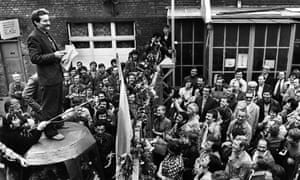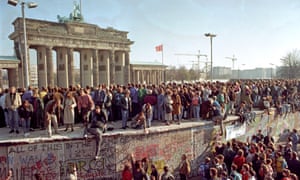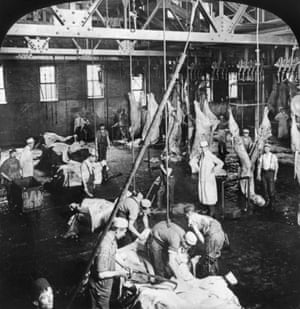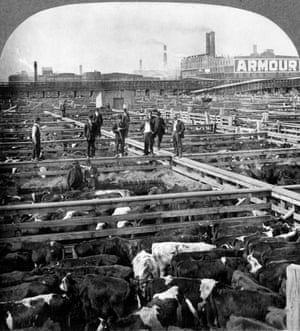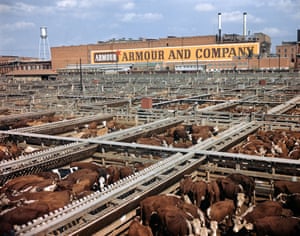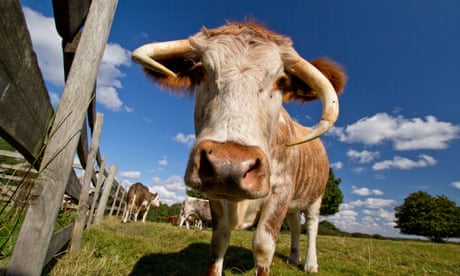It’s time to sound the alarm. Seven decades after the end of the second world war on European soil, the Europe we have built since then is under attack. As the cathedral of Notre Dame burned, Marine Le Pen’s Rassemblement National was polling neck and neck with Emmanuel Macron’s movement for what he calls a “European renaissance”. In Spain, a far-right party called Vox, promoting the kind of reactionary nationalist ideas against which Spain’s post-Franco democracy was supposedly immunised, has won the favour of one in 10 voters in a national election. Nationalist populists rule Italy, where a great-grandson of Benito Mussolini is running for the European parliament on the list of the so-called Brothers of Italy. A rightwing populist party called The Finns, formerly the True Finns (to distinguish them from “false” Finns of different colour or religion), garnered almost as many votes as Finland’s Social Democrats in last month’s general election. In Britain, the European elections on 23 May can be seen as another referendum on Brexit, but the underlying struggle is the same as that of our fellow Europeans. Nigel Farage is a Le Pen in Wellington boots, a True Finn in a Barbour jacket.
Meanwhile, to mark the 30th anniversary of the velvet revolutions of 1989, Poland’s ruling Law and Justice party has denounced a charter of LGBT+ rights as an attack on children. In Germany, the Alternative für Deutschland successfully deploys a völkisch rhetoric we thought vanquished for good, although now it scapegoats Muslims instead of Jews. Remember Bertolt Brecht’s warning: “The womb is fertile still/ from which that crawled.” Viktor Orbán, the young revolutionary hero of 1989 turned bulldog-jowled neo-authoritarian, has effectively demolished liberal democracy in Hungary, using antisemitic attacks on the billionaire George Soros and generous subsidies from the EU. He has also enjoyed political protection from Manfred Weber, the Bavarian politician whom the European People’s party, Europe’s powerful centre-right grouping, suggests should be the next president of the European commission. Orbán has summed the situation up like this: “Thirty years ago, we thought Europe was our future. Today, we believe we are Europe’s future.”
Italy’s Matteo Salvini agrees, so much so that he is hosting an election rally of Europe’s rightwing populist parties, an international of nationalists, in Milan later this month. To be sure, the spectacle of a once-great country reducing itself to a global laughing stock, in a tragic farce called Brexit, has silenced all talk of Hungexit, Polexit or Italexit. But what Orbán and co intend is actually more dangerous. Farage merely wants to leave the EU; they propose to dismantle it from within, returning to an ill-defined but obviously much looser “Europe of nations”.
Wherever one looks, old and new rifts appear, between northern and southern Europe, catalysed by the Eurozone crisis, between west and east, reviving the old stereotypes of intra-European orientalism (civilised west, barbaric east), between Catalonia and the rest of Spain, between two halves of each European society, and even between France and Germany.
For anyone who takes a longer view, these mounting signs of European disintegration should not be a surprise. Isn’t this a pattern familiar from European history? In the 17th century, the horrendously destructive thirty years war was concluded by the peace of Westphalia. At the turn of the 18th to the 19th, the continent was torn apart by two decades of Napoleonic wars, then stitched together in another pattern by the Congress of Vienna. The first world war was followed by the Versailles peace. Each time, the new post-war European order lasts a while – sometimes shorter, sometimes longer – but gradually frays at the edges, with tectonic tensions building up under the surface, until it finally breaks apart in a new time of troubles. No European settlement, order, empire, commonwealth, res publica, Reich, concert, entente, axis, alliance, coalition or union lasts for ever.
Set against that historical measuring rod, our Europe has done pretty well: it is 74 years old this week, if we date its birth to the end of the second world war in Europe. It owes this longevity to the miraculously non-violent collapse in 1989-91 of a nuclear-armed Russian empire that had occupied half the continent. Only in former Yugoslavia, and more recently in Ukraine, have we witnessed what more normally follows the fall of empires: bloody strife. Otherwise, what happened after the end of the cold war was a peaceful enlargement and deepening of the existing, post-1945 west European order. Yet maybe now the muse of history is shouting, like some grim boatman from the shore, “come in Number 45, your time is up!”
Santiago Abascal, the leader of Vox, a far-right party in Spain. Photograph: Pablo Blázquez Domínguez/Getty
In one respect, however, this time is different. For centuries, Europe kept tearing itself apart, then putting itself together again, but all the while exploiting, colonising and bossing around other parts of the world. With the European civil war that raged on and off from 1914 to 1945, once described by Winston Churchill as a second thirty years war, Europe deposed itself from its global throne. In act five of Europe’s self-destruction, the US and the Soviet Union strode on to the stage like Fortinbras at the end of Hamlet. Yet, Europe was at least still the central stage of world politics throughout the cold war that followed. Europeans made history once again for a brief shining moment in 1989, but then Hegel’s Weltgeist, the “world spirit”, moved rapidly on from Berlin to Beijing.
Today, Europe struggles to remain a subject rather than becoming merely an object of world politics – with Beijing hungry to shape a Chinese century, a revanchist Russia, Donald Trump’s unilateralist US, and climate change threatening to overwhelm us all. Both Russia and China merrily divide and rule across our continent, using economic power to pick off weaker European states and disinformation to set nation against nation. In the 19th century, European powers engaged in what was called the scramble for Africa; in the 21st, outside powers engage in a scramble for Europe.
Of course, Europe means many different things. It is a continent with ill-defined borders, a shared culture and history, a contested set of values, a complex web of institutions and, not least, hundreds of millions of people, all with their own individual Europes. Nationalists like Le Pen and Orbán insist they just want a different kind of Europe. Tell me your Europe and I will tell you who you are. But the central institution of the post-1945 project of Europeans working closely together is the European Union, and its future is now in question.
None of this radicalisation and disintegration is inevitable, but to avert it, we have to understand how we got here, and why this Europe, with all its faults, is still worth defending.
It is 1942. In a tram rattling through Nazi-occupied Warsaw sits an emaciated, half-starved 10-year-old boy. His name is Bronek. He is wearing four sweaters, yet still he shivers despite the August heat. Everyone looks at him curiously. Everyone, he is sure, sees that he is a Jewish kid who has slipped out of the ghetto through a hole in the wall. Luckily, no one denounces him, and one Polish passenger warns him to watch out for a German sitting in the section marked “Nur für Deutsche”. And so Bronek survives, while his father is murdered in a Nazi extermination camp and his brother sent to Bergen-Belsen.
Sixty years on, I was walking with Bronek down one of the long corridors of the parliament of a now-independent Poland. Suddenly he stopped in his tracks, turned to me, stroked his beard and said with quiet passion: “You know, for me, Europe is something like a Platonic essence.”
In the life of Prof Bronisław Geremek, you have the essential story of how, and why, Europe came to be what it is today. Having escaped the horrors of the ghetto (“the world burned before my eyes”), along with his mother, he was brought up by a Polish Catholic stepfather, served as an altar boy and was taught by an inspiring priest in the Sodality of the Blessed Virgin Mary. So he had also, in his bones, Europe’s deep and defining Christian heritage. Then, at the age of 18, he joined the communist party, believing it would build a better world. Eighteen years later, stripped of his last illusions by the Soviet invasion of Czechoslovakia in 1968, he resigned from that same party in protest and returned to his professional life as a medieval historian. But politics somehow would not let him go.
I first encountered him during a historic occupation strike in the Lenin Shipyard in Gdańsk in August 1980, when the leader of the striking workers, Lech Wałęsa, asked Geremek to become an adviser to the protest movement that would soon be christened Solidarity. Over the subsequent decade I would visit him, whenever I got the chance, in his small apartment in Warsaw’s Old Town, which had been razed to the ground by the Nazis, then rebuilt stone upon stone by the Poles. As he puffed away at his professorial pipe, he shared with me his pellucid analysis of the decline of the Soviet empire, even as he and his comrades in Solidarity helped turn that decline into fall. For in 1989, he was the intellectual architect of the round table talks that were the key to Poland’s negotiated transition from communism to democracy, and Poland was the icebreaker for the rest of central Europe.
Ten years on, he was the foreign minister who signed the treaty by which Poland became a member of Nato. When I visited him in the foreign ministry, I spotted on his mantelpiece a bottle of a Czech vodka called Stalin’s Tears. “You must have it!” he exclaimed. “A Polish foreign minister cannot keep Stalin in his office!” And so that bottle of Stalin’s Tears stands on my mantelpiece in Oxford as I write. In memory of Bronek, I will never drink it.
In one respect, however, this time is different. For centuries, Europe kept tearing itself apart, then putting itself together again, but all the while exploiting, colonising and bossing around other parts of the world. With the European civil war that raged on and off from 1914 to 1945, once described by Winston Churchill as a second thirty years war, Europe deposed itself from its global throne. In act five of Europe’s self-destruction, the US and the Soviet Union strode on to the stage like Fortinbras at the end of Hamlet. Yet, Europe was at least still the central stage of world politics throughout the cold war that followed. Europeans made history once again for a brief shining moment in 1989, but then Hegel’s Weltgeist, the “world spirit”, moved rapidly on from Berlin to Beijing.
Today, Europe struggles to remain a subject rather than becoming merely an object of world politics – with Beijing hungry to shape a Chinese century, a revanchist Russia, Donald Trump’s unilateralist US, and climate change threatening to overwhelm us all. Both Russia and China merrily divide and rule across our continent, using economic power to pick off weaker European states and disinformation to set nation against nation. In the 19th century, European powers engaged in what was called the scramble for Africa; in the 21st, outside powers engage in a scramble for Europe.
Of course, Europe means many different things. It is a continent with ill-defined borders, a shared culture and history, a contested set of values, a complex web of institutions and, not least, hundreds of millions of people, all with their own individual Europes. Nationalists like Le Pen and Orbán insist they just want a different kind of Europe. Tell me your Europe and I will tell you who you are. But the central institution of the post-1945 project of Europeans working closely together is the European Union, and its future is now in question.
None of this radicalisation and disintegration is inevitable, but to avert it, we have to understand how we got here, and why this Europe, with all its faults, is still worth defending.
It is 1942. In a tram rattling through Nazi-occupied Warsaw sits an emaciated, half-starved 10-year-old boy. His name is Bronek. He is wearing four sweaters, yet still he shivers despite the August heat. Everyone looks at him curiously. Everyone, he is sure, sees that he is a Jewish kid who has slipped out of the ghetto through a hole in the wall. Luckily, no one denounces him, and one Polish passenger warns him to watch out for a German sitting in the section marked “Nur für Deutsche”. And so Bronek survives, while his father is murdered in a Nazi extermination camp and his brother sent to Bergen-Belsen.
Sixty years on, I was walking with Bronek down one of the long corridors of the parliament of a now-independent Poland. Suddenly he stopped in his tracks, turned to me, stroked his beard and said with quiet passion: “You know, for me, Europe is something like a Platonic essence.”
In the life of Prof Bronisław Geremek, you have the essential story of how, and why, Europe came to be what it is today. Having escaped the horrors of the ghetto (“the world burned before my eyes”), along with his mother, he was brought up by a Polish Catholic stepfather, served as an altar boy and was taught by an inspiring priest in the Sodality of the Blessed Virgin Mary. So he had also, in his bones, Europe’s deep and defining Christian heritage. Then, at the age of 18, he joined the communist party, believing it would build a better world. Eighteen years later, stripped of his last illusions by the Soviet invasion of Czechoslovakia in 1968, he resigned from that same party in protest and returned to his professional life as a medieval historian. But politics somehow would not let him go.
I first encountered him during a historic occupation strike in the Lenin Shipyard in Gdańsk in August 1980, when the leader of the striking workers, Lech Wałęsa, asked Geremek to become an adviser to the protest movement that would soon be christened Solidarity. Over the subsequent decade I would visit him, whenever I got the chance, in his small apartment in Warsaw’s Old Town, which had been razed to the ground by the Nazis, then rebuilt stone upon stone by the Poles. As he puffed away at his professorial pipe, he shared with me his pellucid analysis of the decline of the Soviet empire, even as he and his comrades in Solidarity helped turn that decline into fall. For in 1989, he was the intellectual architect of the round table talks that were the key to Poland’s negotiated transition from communism to democracy, and Poland was the icebreaker for the rest of central Europe.
Ten years on, he was the foreign minister who signed the treaty by which Poland became a member of Nato. When I visited him in the foreign ministry, I spotted on his mantelpiece a bottle of a Czech vodka called Stalin’s Tears. “You must have it!” he exclaimed. “A Polish foreign minister cannot keep Stalin in his office!” And so that bottle of Stalin’s Tears stands on my mantelpiece in Oxford as I write. In memory of Bronek, I will never drink it.
Lech Wałęsa speaks to workers during a strike at the Gdańsk shipyard in 1980. Photograph: Erazm Ciołek/Forum/Reuters
Having been instrumental in steering his beloved country into the European Union, he subsequently became a member of the European parliament, that same parliament to which we are electing new representatives this month. Tragically, but in a way symbolically, he died in a car accident on the way to Brussels.
Geremek’s story is unique, but the basic form of his Europeanism is typical of three generations of Europe-builders who made our continent what it is today. When you look at how the argument for European integration was advanced in various countries, from the 1940s to the 1990s, each national story seems at first glance very different. But dig a bit deeper and you find the same underlying thought: “We have been in a bad place, we want to be in a better one, and that better place is called Europe.” Many and diverse were the nightmares from which these countries were trying to awake. For Germany, it was the shame and disgrace of the criminal regime that murdered Bronek’s father. For France, it was the humiliation of defeat and occupation; for Britain, relative political and economic decline; for Spain, a fascist dictatorship; for Poland, a communist one. Europe had no shortage of nightmares. But in all these countries, the shape of the pro-European argument was the same. It was an elongated, exuberant pencilled tick: a steep descent, a turn and then an upward line ascending to a better future. A future called Europe.
Personal memories of bad times were a driving force for three distinctive generations. Many of the founding fathers of what is now the European Union were what one might call 14ers, still vividly recalling the horrors of the first world war. (The 14ers included the British prime minister Harold Macmillan, who would talk with a breaking voice of the “lost generation” of his contemporaries). Then came the 39ers like Geremek, indelibly shaped by traumas of war, gulag, occupation and Holocaust. Finally, there was a third cohort, the 68ers, revolting against the war-scarred generation of their parents, yet many of them also having experience of dictatorship in southern and eastern Europe.
The trouble starts when you have arrived in the promised land. Now, for the first time, we have a generation of Europeans – let’s call them the 89ers – who have known nothing but a Europe of closely connected liberal democracies. Call it a European empire or commonwealth, if you will. To be sure, “Europe whole and free” remains an ideal, not a reality, for millions who live here, especially those who are poor, belong to a discriminated minority or seek refuge from across the Mediterranean. But we are closer to that ideal than ever before.
It would be a parody of middle-aged condescension to say “these young people don’t know how lucky they are!”. After all, younger voters are often more pro-European than older ones. But it would not be wrong to say that many 89ers who have grown up in this relatively whole and free continent do not see Europe as a great cause, the way 39ers and 68ers did. Why be passionate about something that already exists? Unless they have grown up in the former Yugoslavia or Ukraine, they are unlikely to have much direct personal experience of just how quickly things can all unravel, back to European barbarism. By contrast, many of them do know from bitter experience how life got worse after the financial crisis of 2008.
On the walls of Al-Andalus, a tapas bar in Oxford, depictions of flamenco dancers and bullfights embrace cliche without shame. Here, when I first met him in 2015, Julio – dark-haired, lean and intense – worked as a waiter. But serving tourists in a tapas bar in England was not what he expected to be doing with his life. He had just finished a master’s degree in European studies at Computense University in Madrid. It was the Eurozone crisis – which at its height made one in every two young Spaniards unemployed – that reduced him to this. Looking back, Julio describes his feelings when he had to make this move abroad: “Sadness, impotence, solitude.”
Across the continent there are many thousands of Julios. For them, the tick line has been inverted: it started by going steadily up, but then turned sharply downwards after 2008. Ten years ago, you and your country were in a better place. Now you are in a worse one, and that is because Europe has not delivered on its promises.
Here is the cunning of history: the seeds of triumph are sown in the moment of greatest disaster, in 1939, but the seeds of crisis are sown in the moment of triumph, in 1989. With the benefit of hindsight, we can see that many of the problems haunting Europe today have their origins in the apparently triumphant transition after the fall of the Berlin Wall. A few far-sighted people warned at the time. The French political philosopher Pierre Hassner wrote in 1991 that, even as we celebrated the triumph of freedom, we should remember that “humankind does not live by liberty and universality alone, that the aspirations that led to nationalism and socialism, the yearning for community and identity, and the yearning for solidarity and equality, will reappear as they always do”. And so they have.
The events of 1989 opened the door to an unprecedented era of globalised, financialised capitalism. While this facilitated great material progress for a new middle class in Asia, in the west it generated levels of economic inequality not seen since the early 20th century. A divide also opened up between those with higher education and international experience, and those in the less fortunate other halves of European societies. The latter felt an inequality of attention and respect from the former. Barriers to freedom of movement between European countries were eliminated while little thought was given to what Europe would do if large numbers of people wanted to enter through the outer frontier of the Schengen zone. What followed was problems of large-scale emigration, for the poorer countries of eastern and southern Europe, and of immigration for the richer ones of northern Europe – be it the internal movement of more than 2 million east Europeans to Britain or the influx of more than 1 million refugees from outside the EU to Germany.
When the global financial crisis hit, it exposed all the inherent flaws of a halfway-house Eurozone. Hastened into life as a political response to German unification, the Eurozone that we have today, a common currency without a common treasury, hitching together such diverse economies as those of Greece and Germany, had been warned against in vain by numerous economists. Absent a decisive, far-sighted response from northern Europe, and especially from Germany, the impact on southern Europe was traumatic. Not only did the Eurozone crisis drive Julio to that dreary tapas bar and people in Greece to desperate hardship; it kick-started a new wave of radical and populist politics, on both left and right, and with mixtures of left and right that don’t easily fit into that old dichotomy.
Populists blame the sufferings of “the people” on remote, technocratic, liberal elites. Europe, or more accurately “Europe”, is particularly vulnerable to this attack. For most officials in Brussels are quite remote, quite technocratic and quite liberal. Although members of the European parliament are directly elected, that parliament can at times seem like a bubble within the Brussels bubble. Although their remuneration is peanuts compared to that of the bankers who nearly crashed the globalised capitalist system, EU leaders, parliamentarians and officials are very well paid. Watching them jump out of a chauffeur-driven BMW to deliver another smooth, visionary speech about the future of Europe, before jumping back into the BMW to be swept off to another nice lunch, it is not surprising that many less privileged Europeans say: “Well, they would praise Europe, wouldn’t they?”
Earlier this year, in a shabby office in Westminster, I was talking to someone who, like me, passionately wants a second referendum on Brexit, in which the majority votes to remain in the EU. What should be our campaign slogan? Among others, he suggested “Europe is great!” I winced. Why? Because this calls to mind the toe-curling British government national promotion campaign built around the motto “Britain is GREAT”. Countries that feel the need to proclaim in capital letters that they are great probably no longer are. But also because of all these problems that have accumulated across Europe during the 30 years of peace since 1989. Europe is great for us, the educated, privileged, mobile and gainfully employed, but do you really feel like saying “Europe is great!” with a straight face to the unemployed, unskilled worker in the post-industrial north of England, the southern European graduate who can’t find a job, or the Roma child or the refugee stuck in a camp?
We are only credible if we acknowledge that the European Union is now passing through an existential crisis, under attack from inside and out. It is paying the price both for past successes, which result in its achievements being taken for granted, and past mistakes, many of them having the shared characteristic of liberal over-reach.
The case for Europe today is very different from that of a half-century ago. In the 1970s, people in Britain, Spain or Poland looked at countries like France and West Germany, just coming to the end of the trente glorieuses – the three postwar decades of economic growth – in the then much smaller European Community, and said “we want what they’re having”. Today, the case starts with the defence of a Europe that already exists, but is now threatened with disintegration. If the construction were so strong that we could without hesitation say “Europe is great!”, it would not need our support so badly.
Since its inception, the European project has had a future-oriented, teleological rhetoric, all about what will come to pass one fine day, as we reach some ideal finalité européenne. These habits die hard. Driving through Hannover recently, I saw a Green party poster for the European elections that declared “Europe is not perfect – but it’s a damned good start”. Pause to think for a moment, and you realise how odd this is. After all, we don’t say “Britain is not perfect, but it’s a damned good start”. Nor do most 74-year-olds say “my life is not perfect, but it’s a good start”. The European Union today, like Germany or France or Britain, is a mature political entity, which does not need to derive its legitimacy from some utopian future. There is now a realistic, even conservative (with a small c) argument for maintaining what has already been built – which, of course, necessarily also means reforming it. If we merely preserved for the next 30 years today’s EU, at its current levels of freedom, prosperity, security and cooperation, that would already be an astonishing achievement.
Having been instrumental in steering his beloved country into the European Union, he subsequently became a member of the European parliament, that same parliament to which we are electing new representatives this month. Tragically, but in a way symbolically, he died in a car accident on the way to Brussels.
Geremek’s story is unique, but the basic form of his Europeanism is typical of three generations of Europe-builders who made our continent what it is today. When you look at how the argument for European integration was advanced in various countries, from the 1940s to the 1990s, each national story seems at first glance very different. But dig a bit deeper and you find the same underlying thought: “We have been in a bad place, we want to be in a better one, and that better place is called Europe.” Many and diverse were the nightmares from which these countries were trying to awake. For Germany, it was the shame and disgrace of the criminal regime that murdered Bronek’s father. For France, it was the humiliation of defeat and occupation; for Britain, relative political and economic decline; for Spain, a fascist dictatorship; for Poland, a communist one. Europe had no shortage of nightmares. But in all these countries, the shape of the pro-European argument was the same. It was an elongated, exuberant pencilled tick: a steep descent, a turn and then an upward line ascending to a better future. A future called Europe.
Personal memories of bad times were a driving force for three distinctive generations. Many of the founding fathers of what is now the European Union were what one might call 14ers, still vividly recalling the horrors of the first world war. (The 14ers included the British prime minister Harold Macmillan, who would talk with a breaking voice of the “lost generation” of his contemporaries). Then came the 39ers like Geremek, indelibly shaped by traumas of war, gulag, occupation and Holocaust. Finally, there was a third cohort, the 68ers, revolting against the war-scarred generation of their parents, yet many of them also having experience of dictatorship in southern and eastern Europe.
The trouble starts when you have arrived in the promised land. Now, for the first time, we have a generation of Europeans – let’s call them the 89ers – who have known nothing but a Europe of closely connected liberal democracies. Call it a European empire or commonwealth, if you will. To be sure, “Europe whole and free” remains an ideal, not a reality, for millions who live here, especially those who are poor, belong to a discriminated minority or seek refuge from across the Mediterranean. But we are closer to that ideal than ever before.
It would be a parody of middle-aged condescension to say “these young people don’t know how lucky they are!”. After all, younger voters are often more pro-European than older ones. But it would not be wrong to say that many 89ers who have grown up in this relatively whole and free continent do not see Europe as a great cause, the way 39ers and 68ers did. Why be passionate about something that already exists? Unless they have grown up in the former Yugoslavia or Ukraine, they are unlikely to have much direct personal experience of just how quickly things can all unravel, back to European barbarism. By contrast, many of them do know from bitter experience how life got worse after the financial crisis of 2008.
On the walls of Al-Andalus, a tapas bar in Oxford, depictions of flamenco dancers and bullfights embrace cliche without shame. Here, when I first met him in 2015, Julio – dark-haired, lean and intense – worked as a waiter. But serving tourists in a tapas bar in England was not what he expected to be doing with his life. He had just finished a master’s degree in European studies at Computense University in Madrid. It was the Eurozone crisis – which at its height made one in every two young Spaniards unemployed – that reduced him to this. Looking back, Julio describes his feelings when he had to make this move abroad: “Sadness, impotence, solitude.”
Across the continent there are many thousands of Julios. For them, the tick line has been inverted: it started by going steadily up, but then turned sharply downwards after 2008. Ten years ago, you and your country were in a better place. Now you are in a worse one, and that is because Europe has not delivered on its promises.
Here is the cunning of history: the seeds of triumph are sown in the moment of greatest disaster, in 1939, but the seeds of crisis are sown in the moment of triumph, in 1989. With the benefit of hindsight, we can see that many of the problems haunting Europe today have their origins in the apparently triumphant transition after the fall of the Berlin Wall. A few far-sighted people warned at the time. The French political philosopher Pierre Hassner wrote in 1991 that, even as we celebrated the triumph of freedom, we should remember that “humankind does not live by liberty and universality alone, that the aspirations that led to nationalism and socialism, the yearning for community and identity, and the yearning for solidarity and equality, will reappear as they always do”. And so they have.
The events of 1989 opened the door to an unprecedented era of globalised, financialised capitalism. While this facilitated great material progress for a new middle class in Asia, in the west it generated levels of economic inequality not seen since the early 20th century. A divide also opened up between those with higher education and international experience, and those in the less fortunate other halves of European societies. The latter felt an inequality of attention and respect from the former. Barriers to freedom of movement between European countries were eliminated while little thought was given to what Europe would do if large numbers of people wanted to enter through the outer frontier of the Schengen zone. What followed was problems of large-scale emigration, for the poorer countries of eastern and southern Europe, and of immigration for the richer ones of northern Europe – be it the internal movement of more than 2 million east Europeans to Britain or the influx of more than 1 million refugees from outside the EU to Germany.
When the global financial crisis hit, it exposed all the inherent flaws of a halfway-house Eurozone. Hastened into life as a political response to German unification, the Eurozone that we have today, a common currency without a common treasury, hitching together such diverse economies as those of Greece and Germany, had been warned against in vain by numerous economists. Absent a decisive, far-sighted response from northern Europe, and especially from Germany, the impact on southern Europe was traumatic. Not only did the Eurozone crisis drive Julio to that dreary tapas bar and people in Greece to desperate hardship; it kick-started a new wave of radical and populist politics, on both left and right, and with mixtures of left and right that don’t easily fit into that old dichotomy.
Populists blame the sufferings of “the people” on remote, technocratic, liberal elites. Europe, or more accurately “Europe”, is particularly vulnerable to this attack. For most officials in Brussels are quite remote, quite technocratic and quite liberal. Although members of the European parliament are directly elected, that parliament can at times seem like a bubble within the Brussels bubble. Although their remuneration is peanuts compared to that of the bankers who nearly crashed the globalised capitalist system, EU leaders, parliamentarians and officials are very well paid. Watching them jump out of a chauffeur-driven BMW to deliver another smooth, visionary speech about the future of Europe, before jumping back into the BMW to be swept off to another nice lunch, it is not surprising that many less privileged Europeans say: “Well, they would praise Europe, wouldn’t they?”
Earlier this year, in a shabby office in Westminster, I was talking to someone who, like me, passionately wants a second referendum on Brexit, in which the majority votes to remain in the EU. What should be our campaign slogan? Among others, he suggested “Europe is great!” I winced. Why? Because this calls to mind the toe-curling British government national promotion campaign built around the motto “Britain is GREAT”. Countries that feel the need to proclaim in capital letters that they are great probably no longer are. But also because of all these problems that have accumulated across Europe during the 30 years of peace since 1989. Europe is great for us, the educated, privileged, mobile and gainfully employed, but do you really feel like saying “Europe is great!” with a straight face to the unemployed, unskilled worker in the post-industrial north of England, the southern European graduate who can’t find a job, or the Roma child or the refugee stuck in a camp?
We are only credible if we acknowledge that the European Union is now passing through an existential crisis, under attack from inside and out. It is paying the price both for past successes, which result in its achievements being taken for granted, and past mistakes, many of them having the shared characteristic of liberal over-reach.
The case for Europe today is very different from that of a half-century ago. In the 1970s, people in Britain, Spain or Poland looked at countries like France and West Germany, just coming to the end of the trente glorieuses – the three postwar decades of economic growth – in the then much smaller European Community, and said “we want what they’re having”. Today, the case starts with the defence of a Europe that already exists, but is now threatened with disintegration. If the construction were so strong that we could without hesitation say “Europe is great!”, it would not need our support so badly.
Since its inception, the European project has had a future-oriented, teleological rhetoric, all about what will come to pass one fine day, as we reach some ideal finalité européenne. These habits die hard. Driving through Hannover recently, I saw a Green party poster for the European elections that declared “Europe is not perfect – but it’s a damned good start”. Pause to think for a moment, and you realise how odd this is. After all, we don’t say “Britain is not perfect, but it’s a damned good start”. Nor do most 74-year-olds say “my life is not perfect, but it’s a good start”. The European Union today, like Germany or France or Britain, is a mature political entity, which does not need to derive its legitimacy from some utopian future. There is now a realistic, even conservative (with a small c) argument for maintaining what has already been built – which, of course, necessarily also means reforming it. If we merely preserved for the next 30 years today’s EU, at its current levels of freedom, prosperity, security and cooperation, that would already be an astonishing achievement.
The fall of the Berlin Wall in 1989. Photograph: Alamy
In a long historical perspective, this is the best Europe we have ever had. I challenge you to point to a better one, for the majority of the continent’s countries and individual people. Most Europeans live in liberal democracies that are committed to resolving their differences by all-night meetings in Brussels, not unilateral action, let alone armed force. This European Union is not a country, and will not become one any time soon, but it is much more than just an international organisation. The former Italian prime minister Giuliano Amato describes it as an unidentified flying object. It may be short on mystique, on emotional appeal, but it is not lacking that entirely. The heart can lift to see European flags fluttering beside national ones, and certainly to the strains of the European anthem, Beethoven’s setting of the Ode to Joy.
For everyone who is a citizen of an EU member state, this is a continent where you can wake up on a Friday morning, decide to take a budget airline flight to the other end of the continent, meet someone you like, settle down to study, work and live there, all the time enjoying the rights of a European citizen in one and the same legal, economic and political community. All this you appreciate most, like health, when you are about to lose it. Small wonder that marchers at the huge pro-European demonstration in London on 23 March this year wore T-shirts proclaiming “I am a citizen of Europe”.
So here’s the deepest challenge of this moment: do we really need to lose it all in order to find it again? Born in the depths of European barbarism more than 70 years ago, tipped towards crisis by a hubris born of that liberal triumph 30 years ago, does this project of a better Europe really need to descend all the way down to barbarism again before people mobilise to bring it back up? As personal memories like those that inspired the European passion of Bronisław Geremek fade away, the question is whether collective memory, cultivated by historians, journalists, novelists, statespeople and film-makers, can enable us to learn the lessons of the past without going through it all again ourselves.
Julio thinks we can learn. That is why, having resumed his academic career in Spain, he is now standing in the European elections for a radical, transnational pro-European party called Volt. “The generation that I represent,” he wrote to me in a recent email, “has observed the beginning of the disintegration of the EU, because of the triumph of the Brexit referendum. Imagine exit referendums across the EU in the next 10 or 20 years; the EU could easily be dismantled … So nothing will stand if we don’t defend what we have achieved after so many generations of sacrifice.”
You don’t have to subscribe to the electric radicalism of Volt’s pan-European federalist programme to appreciate the force of Julio’s appeal. I myself think more gradualist recipes for EU reform are more realistic. There are multiple variants of pro-Europeanism on offer from different parties in this month’s European elections, most of them acknowledging the need for reform. In Britain, five parties (not including Labour) are unambiguously in favour of the country staying in the EU. What is clear is that for once, and at last, these European elections really are about the future of Europe. Across 28 countries, new parties and old ghosts compete for the hearts of voters, with close to 100 million of them still undecided how they will vote. What is called for now, in every corner of our continent, is the defence of our common European home, not with arms but through the ballot box. Your continent needs you.
In a long historical perspective, this is the best Europe we have ever had. I challenge you to point to a better one, for the majority of the continent’s countries and individual people. Most Europeans live in liberal democracies that are committed to resolving their differences by all-night meetings in Brussels, not unilateral action, let alone armed force. This European Union is not a country, and will not become one any time soon, but it is much more than just an international organisation. The former Italian prime minister Giuliano Amato describes it as an unidentified flying object. It may be short on mystique, on emotional appeal, but it is not lacking that entirely. The heart can lift to see European flags fluttering beside national ones, and certainly to the strains of the European anthem, Beethoven’s setting of the Ode to Joy.
For everyone who is a citizen of an EU member state, this is a continent where you can wake up on a Friday morning, decide to take a budget airline flight to the other end of the continent, meet someone you like, settle down to study, work and live there, all the time enjoying the rights of a European citizen in one and the same legal, economic and political community. All this you appreciate most, like health, when you are about to lose it. Small wonder that marchers at the huge pro-European demonstration in London on 23 March this year wore T-shirts proclaiming “I am a citizen of Europe”.
So here’s the deepest challenge of this moment: do we really need to lose it all in order to find it again? Born in the depths of European barbarism more than 70 years ago, tipped towards crisis by a hubris born of that liberal triumph 30 years ago, does this project of a better Europe really need to descend all the way down to barbarism again before people mobilise to bring it back up? As personal memories like those that inspired the European passion of Bronisław Geremek fade away, the question is whether collective memory, cultivated by historians, journalists, novelists, statespeople and film-makers, can enable us to learn the lessons of the past without going through it all again ourselves.
Julio thinks we can learn. That is why, having resumed his academic career in Spain, he is now standing in the European elections for a radical, transnational pro-European party called Volt. “The generation that I represent,” he wrote to me in a recent email, “has observed the beginning of the disintegration of the EU, because of the triumph of the Brexit referendum. Imagine exit referendums across the EU in the next 10 or 20 years; the EU could easily be dismantled … So nothing will stand if we don’t defend what we have achieved after so many generations of sacrifice.”
You don’t have to subscribe to the electric radicalism of Volt’s pan-European federalist programme to appreciate the force of Julio’s appeal. I myself think more gradualist recipes for EU reform are more realistic. There are multiple variants of pro-Europeanism on offer from different parties in this month’s European elections, most of them acknowledging the need for reform. In Britain, five parties (not including Labour) are unambiguously in favour of the country staying in the EU. What is clear is that for once, and at last, these European elections really are about the future of Europe. Across 28 countries, new parties and old ghosts compete for the hearts of voters, with close to 100 million of them still undecided how they will vote. What is called for now, in every corner of our continent, is the defence of our common European home, not with arms but through the ballot box. Your continent needs you.

